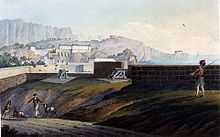Thomas Staunton St. Clair
| Thomas Staunton St. Clair | |
|---|---|
| Born |
1785 Gibraltar |
| Died |
1846 Malta |
| Nationality | British |
Major General Thomas Staunton St. Clair (1785 – 1846) was a British Army officer known for his water-colour paintings which recorded British colonies in Gibraltar and.
Life
St. Clair was born in Gibraltar in 1785 where his father, William, was a colonel of the 25th regiment. Thomas had an elder brother called William who was involved with the mutiny in Gibraltar. William died fighting in Martinique in 1809.[1] He also had a brother David and two sisters. His father was a friend of Prince Edward, Duke of Kent and Strathearn and he was able to use this to advance his career more rapidly.[1]

He signed up for the British Army joining the 94th Regiment of Foot in 1803 and the following year he was a Lieutenant. In 1814 he was awarded an Army Gold Medal for his part in the Battle of the Nive.[2] By 21 June 1817 he was a Lieutenant Colonel.[3]
In 1820, St. Clair returned to the Rock of Gibraltar as one of the senior officers in command of the Garrison at the age of just 36.
In 1832 he was sent to Malta and in 1834 he published A Soldiers Recollections of the West Indies and America.[1] This included his journey to Stabroek aboard HMS Brilliant that arrived early in 1806 and left him in South America until his return in June 1808.[1]
St. Clair died in Malta in 1846 a year after he was made a Major-General.
Legacy
He married Caroline Woodbridge of Richmond, Surrey who was ten years younger than him and they had children. St.Clair has paintings in Gibraltar Museum
References
| Wikimedia Commons has media related to Thomas Staunton St Clair. |
- ↑ 1.0 1.1 1.2 1.3 St. Clair, Thomas Staunton (1834). A residence in the West Indies and America: Volume 2. Guyana: R Bentley.
- ↑ "Army Gold Medal for Nive awarded to Major-General Thomas Staunton St Clair, 1814". nam.ac.uk. Retrieved 14 March 2013.
- ↑ A List of the Officers of the Army and of the Corps of Royal Marines. Great Britain War Office. 1821. p. 38.